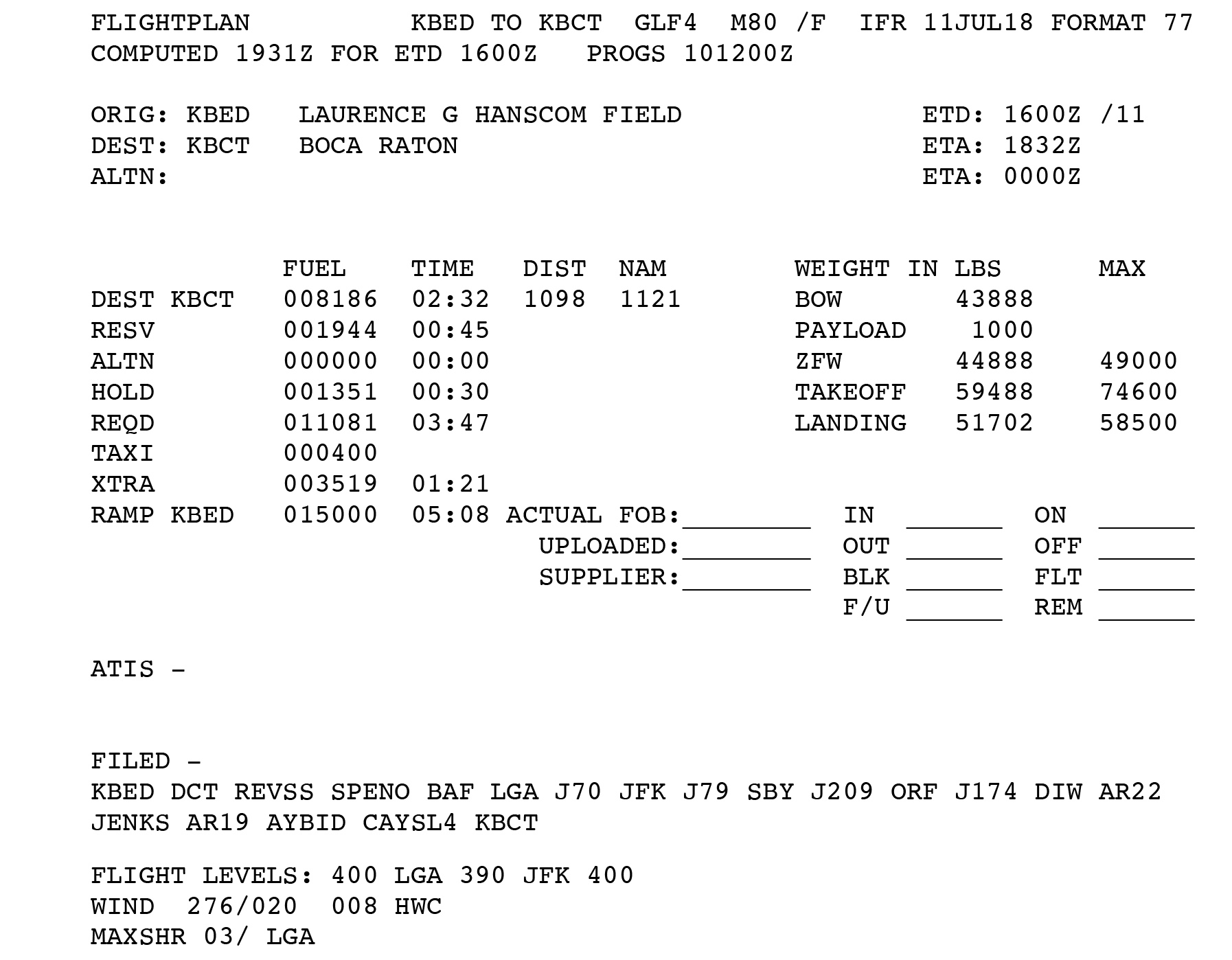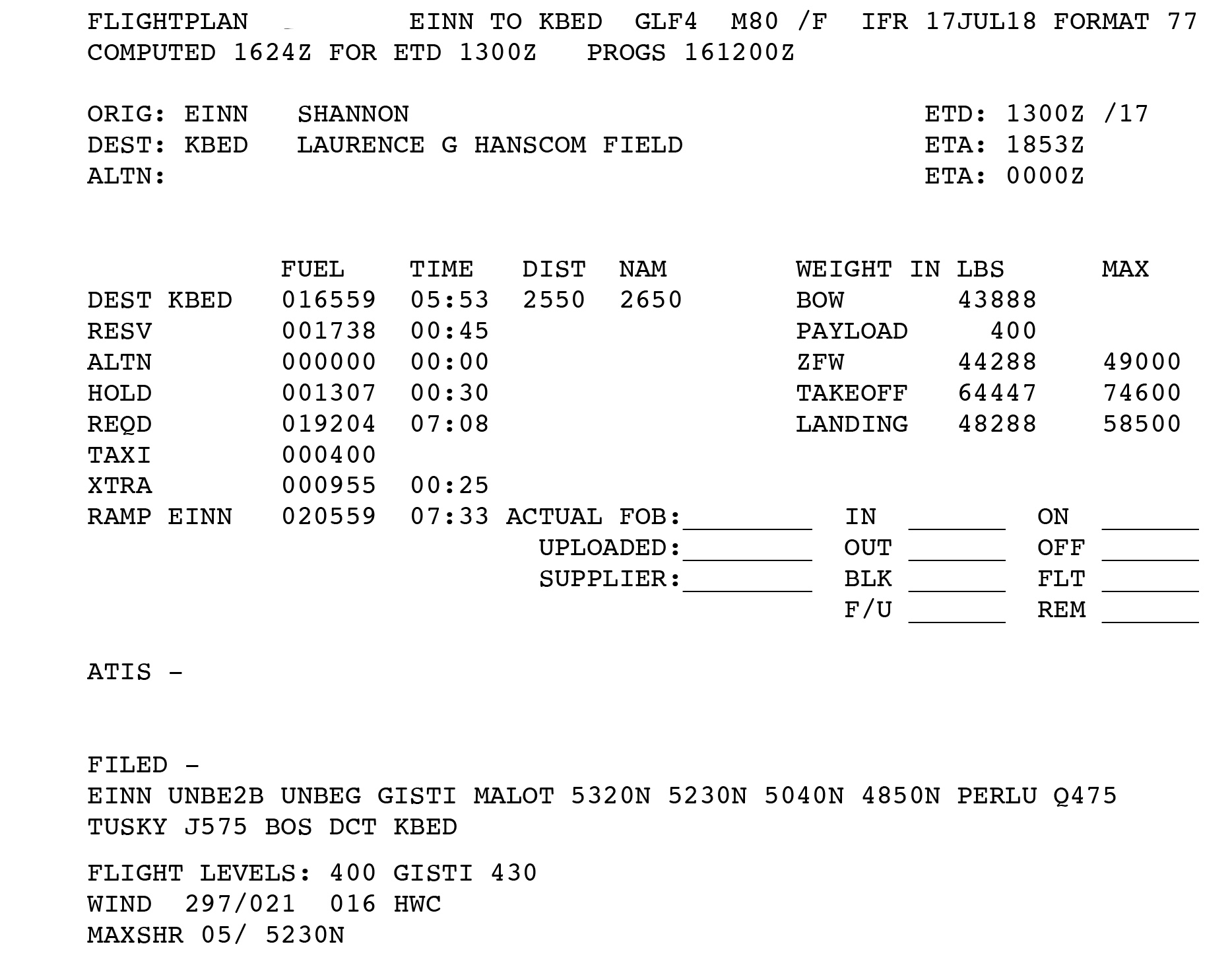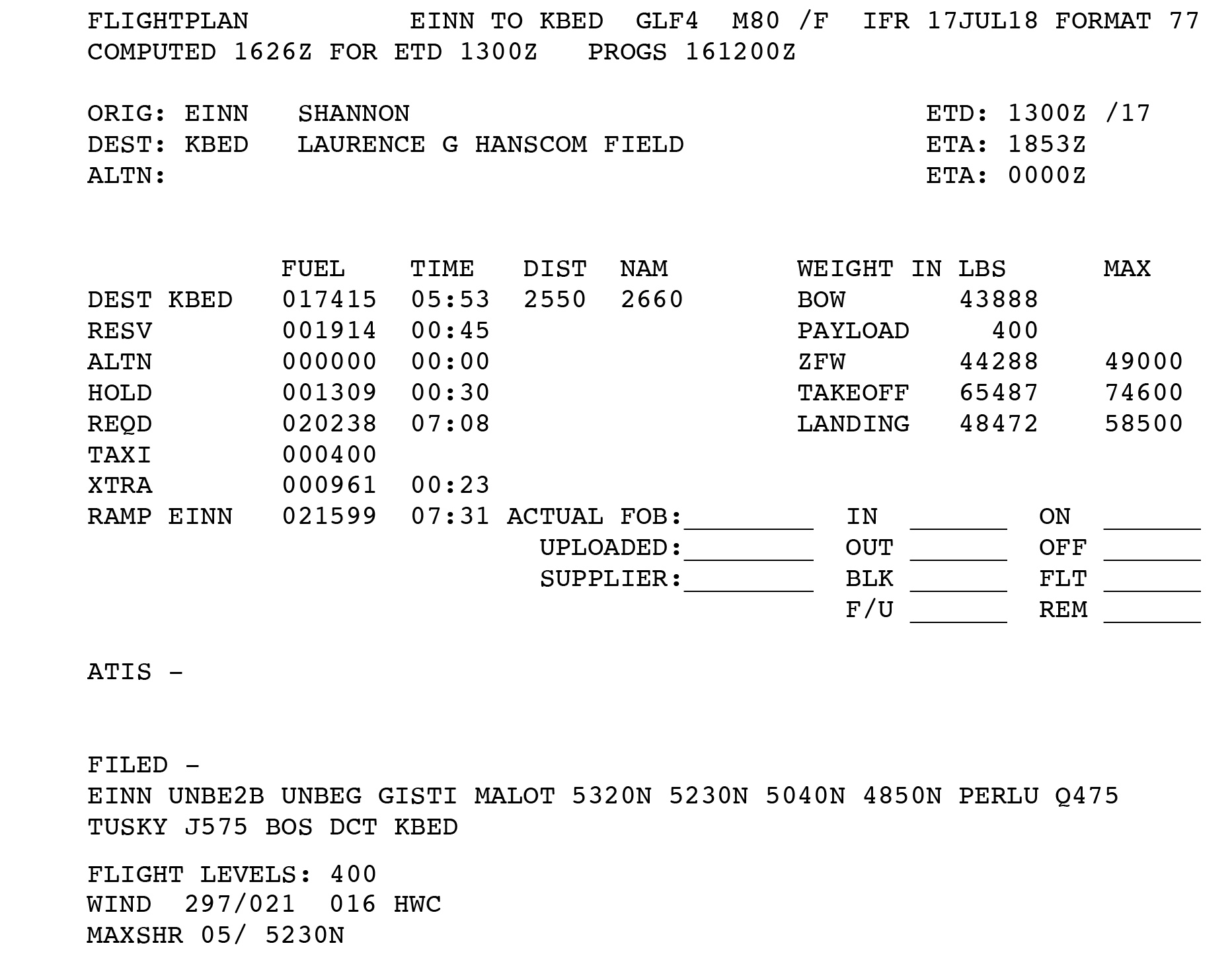You've been hearing this your entire career: "It takes fuel to carry fuel." That is obviously true. But does it take enough fuel to matter? As with many things in aviation, the answer is: "It depends." It depends if the weight of the aircraft is going to impact your altitude selection.
— James Albright

Updated:
2018-07-16
I've always treated this as an assumed truth and never worried about the details because when it matters to me — flying oceanic — my altitude is usually constrained. Then I got an email asking for more details and I realized that I have more choice about altitude these days back in the days before RVSM and datalink. So there is more to the question than when I first dismissed it.

1
An emailed question
James,
I do a bit of contract flying in the GIV. I've observed that most of the pilots I fly with take a look at whatever the "canned" flight plan fuel load is, and that’s what they put on. Sometimes they might "round up" a little bit, like if the fuel load is 17,400, they might make it 18,000 pounds, usually based on a 4000 pound reserve. I’m mostly fine with that especially if it’s day time, reasonably good weather at the destination, plenty of close by alternates with decent wx and/or precision approaches, and you’re not departing from TEB (or similar) where you could easily spend 45 mins to an hour burning fuel on the ground waiting for takeoff some days. But other times, I might be more comfortable with a 6000 pound reserve. So when I say something to that effect to the PIC, the reply is quite often along the lines of, "well you know the smart people handlers and computers that figure all this out, they think this is all we need, with a 4000 lb reserve. And, it costs money to carry extra fuel." Yeah, I know. So here’s my question: is there a simple arithmetic or algebraic equation, based on whatever appropriate variables one might know (or reasonably be able to estimate) that can be used to calculate how much extra fuel will be burned (X) to load up with and carry (Y) amount of extra fuel? I'm not really talking about true tankering of a lot of fuel, but really just - for my GIV purposes - adding an extra 1000, 2000 or maybe 3000 pounds over the flight plan + reserves calculated amount, so I have a more comfortable reserve for a particular set of trip conditions.
Bottom line for me is that my gut feeling is for typical GIV flights of 3-6 hours, there can’t be a huge penalty for carrying an extra couple thousand pounds, especially when considering the overall cost of operating a large cabin Gulfstream. But it’d be nice to have a way of calculating it. Any thoughts on this?
A cautious GIV per diem pilot
Dear Cautious,
There isn't a simple formula that does this for all aircraft, but Gulfstream does offer Fuel Tankering guidance for the G450/550/650 that basically works out to 4% of the additional weight of the additional fuel, per hour:
Using 4% of fuel burn / flight hour as a reference, every extra (not required for the actual flight leg) 100 lbs. of fuel carried, will result in an extra 4 lbs. of fuel burn per hour.
I've found we, in the G450, can extrapolate this to say:
Additional fuel requires 4% of the weight of the fuel per hour if flown at the same cruise altitude. If flown at a lower altitude, the additional fuel is multiplied by the thousands of feet lower times 1.25. (1.25 for 1,000 feet, 2.5 for 2,000 feet, 3.75 for 3,000 feet.)
Like many rules of thumb, this one isn't very good. There isn't a lot of all-engine performance data in our books that help. You can go through the GIV manual and come up with theoreticals, and I've attached some of that. A better way is to simply run a few sample flight plans. I ran four in the G450 for your consideration. The 4% of the additional weight per hour seems to work for us. I think if you run a few flight plans like these you should be able to come up with a percentage of your own. (But you are better off running multiple flight plans.)
My conclusion is that if you are not making altitude decisions based on aircraft weight, it hardly matters. But if the extra fuel keeps you from flying as high as you want to, such as during an oceanic flight, then it may very well be important.
2
Trying math

GIV Twin engine cruise altitude selection,
GIV OM, §11-04-00, figure 1.
Most aircraft manuals are not very helpful when trying to determine how much extra fuel the aircraft will consume given incremental increases in weight. You can get there, but it isn't easy. Using the Gulfstream GIV as an example, the only single chart reference that is of any help is the "Twin Engine Cruise Altitude Selection" chart shown. I've used that as an example to illustrate how to get a basic feel for the amount of fuel required to carry extra fuel.
The GIV manuals aren’t very helpful on this topic and every situation is different, but to illustrate the "takes fuel to carry fuel" argument, consider the attached chart with a very simple question: how much more fuel does it take to carry an extra thousand pounds of fuel for 400 nm at 31,000 feet, using 58,000 and 59,000 lbs gross weight, M.77, ISA?
We see that at 58,000 lbs. gross weight, the mileage is .1335 nm/lb. So 400 nm will consume 400 / .1335 = 2,996 lbs of fuel.
The chart has numbers for 62,000 lbs: .1309 nm/lb. That’s .0026 nm/lb less mileage for an airplane weighs 4,000 lbs more. So divide that difference by 4 and we can say a 59,000 lb aircraft will have a mileage of .1335 - (.0026)/4 = .13285 nm/lb. That means 400 nm will take 400 / .13285 = 3,011 lbs of fuel. That’s just 15 lbs of fuel for that distance.
Of course the taxi and climb will take more fuel too. But the point is that it isn’t much.
3
Altitude selection not constrained
With the exception of our oceanic flights or other long distance flights where getting step climbs is difficult (or impossible), we aren't making altitude choices to optimize fuel. Going from Boston to Teterboro, for example, rarely allows us to pick the best altitude; air traffic control has more to say about this than our fuel charts.
For an example, I've picked two flights from Bedford, Massachusetts (KBED) to Boca Raton, Florida (KBCT) under almost identical conditions. Both are planned along the same route, both a FL 400, M 0.80, and identical weather conditions. The first flight departs with 14,000 lbs. of fuel, the second at 15,000 lbs. of fuel. How much gas does it take to carry an extra 1,000 lbs. of fuel?
In this example, the extra 1,000 lbs of fuel did not impact our flying time but increased our total fuel burn by 55 lbs. Chicken feed. This is much less than 4% per hour of the additional 1,000 lbs, which would be 100 lbs.
4
Altitude selection constrained
A friend of mine who has been a captain at American Airlines for 30+ years also writes a very good aviation blog and once wrote, "You can never have too much fuel." I wrote to him and said, "unless you are on fire." So he amended his blog. Then I wrote, "unless you are too heavy to takeoff." So he amended it again. Then I further wrote, "unless you are trying to make an altitude for an oceanic crossing." He asked me to stop writing.
But the point I was making holds true in this context. If you are crossing the pond and can't bank on a step climb hours into your flight, having too much gas can keep you from starting the hop at a desirable altitude. That can cost you a lot of gas. How much? Here's a hypothetical example.
In years past we used to do Shannon, Ireland (EINN) to Bedford, Massachusetts (KBED) on a regular basis. In the G450 you can do this easily and, if you want, fly above the tracks. Here is an example flight plan, with 4,000 lbs of arrival fuel specified.
As you can see, the flight plan has us level off at FL 400 until allowing a climb to FL 430 at GISTI, which is about five minutes before the oceanic entry point. So we will be able to fly above the North Atlantic Tracks. Now what if we decide we want to leave with an extra 1,000 lbs of fuel?
This flight plan is under identical conditions, but departing with an extra 1,000 lbs of fuel. The aircraft is now too heavy to reach FL 430 by the oceanic entry point and will have to cross at FL 400. You might be able to get a step climb, but that is far from a sure thing. So we have to plan on doing our crossing 3,000 feet lower. Taking the extra 1,000 lbs. of fuel cost us (17,415 - 16,559) = 856 lbs. Using our 4% per hour per 1,000 feet rule of thumb, we would come up with (1,000 lbs) (3.75) (0.04) (6 hours) = 900 lbs.
In this example, we are only getting (1,000 - 856) = 144 lbs of fuel benefit from our effort. This is, admittedly, an extreme case. But it is worth considering when making fueling decisions prior to hopping the pond.
References
(Source material)
Gulfstream GIV Operating Manual, Revision 9, October 11, 2002
Gulfstream All Aircraft Fuel Tanker, Rev 0.0.0
Please note: Gulfstream Aerospace Corporation has no affiliation or connection whatsoever with this website, and Gulfstream does not review, endorse, or approve any of the content included on the site. As a result, Gulfstream is not responsible or liable for your use of any materials or information obtained from this site.




